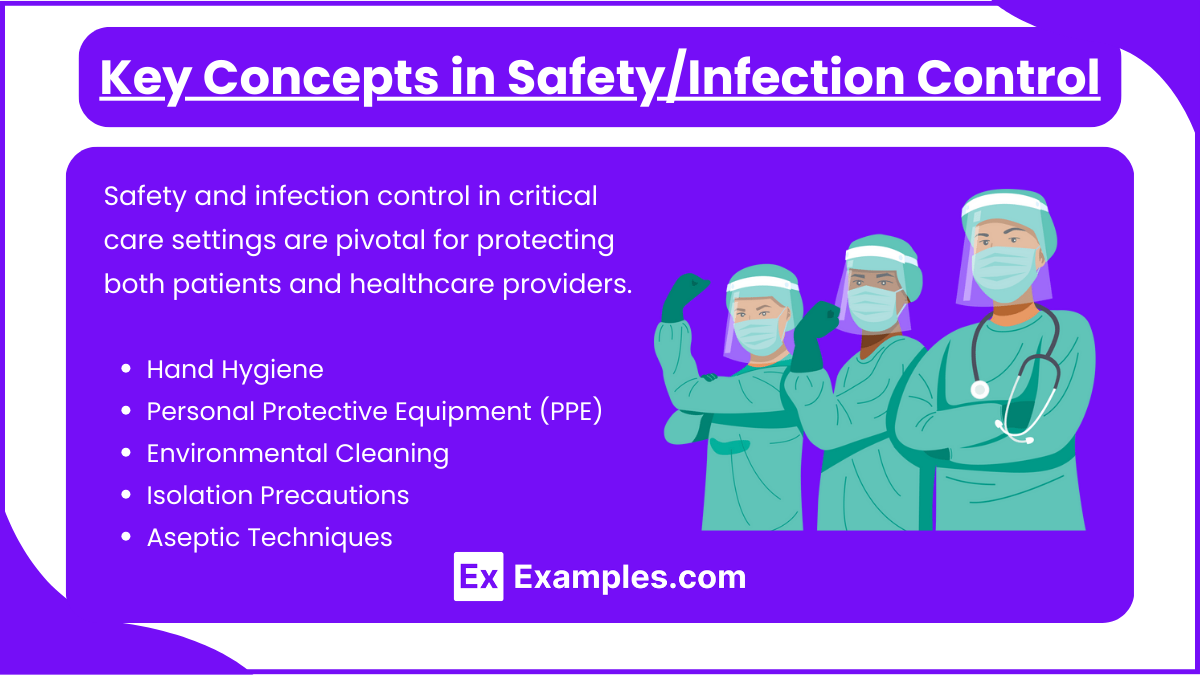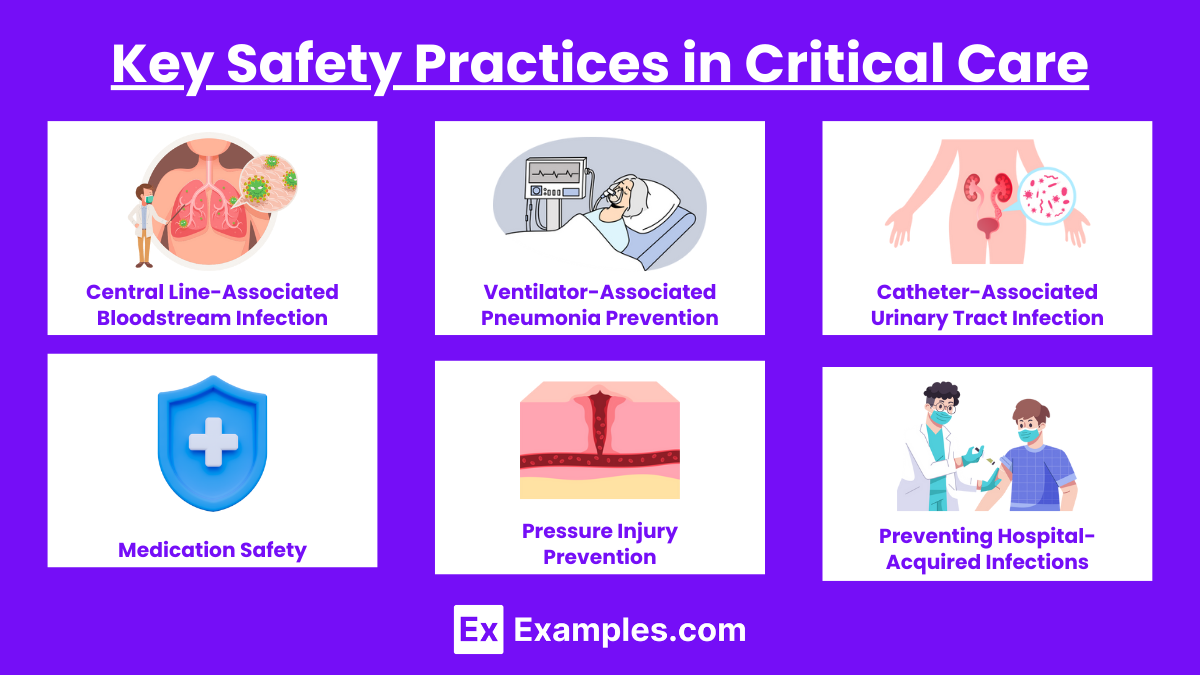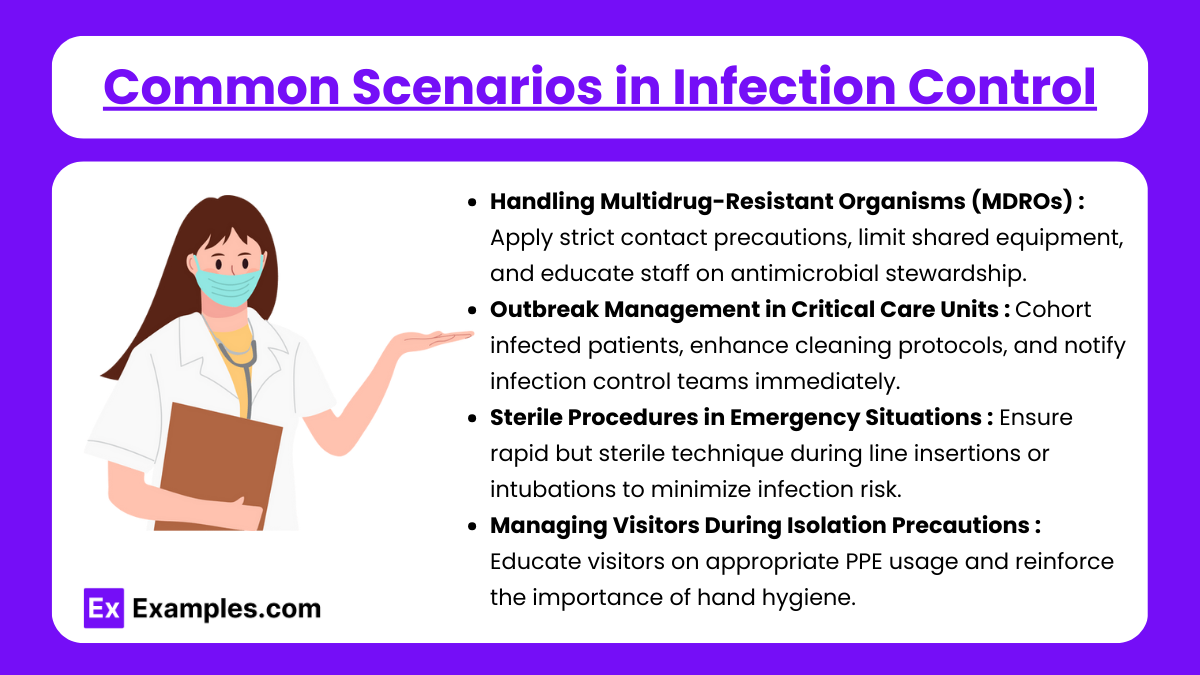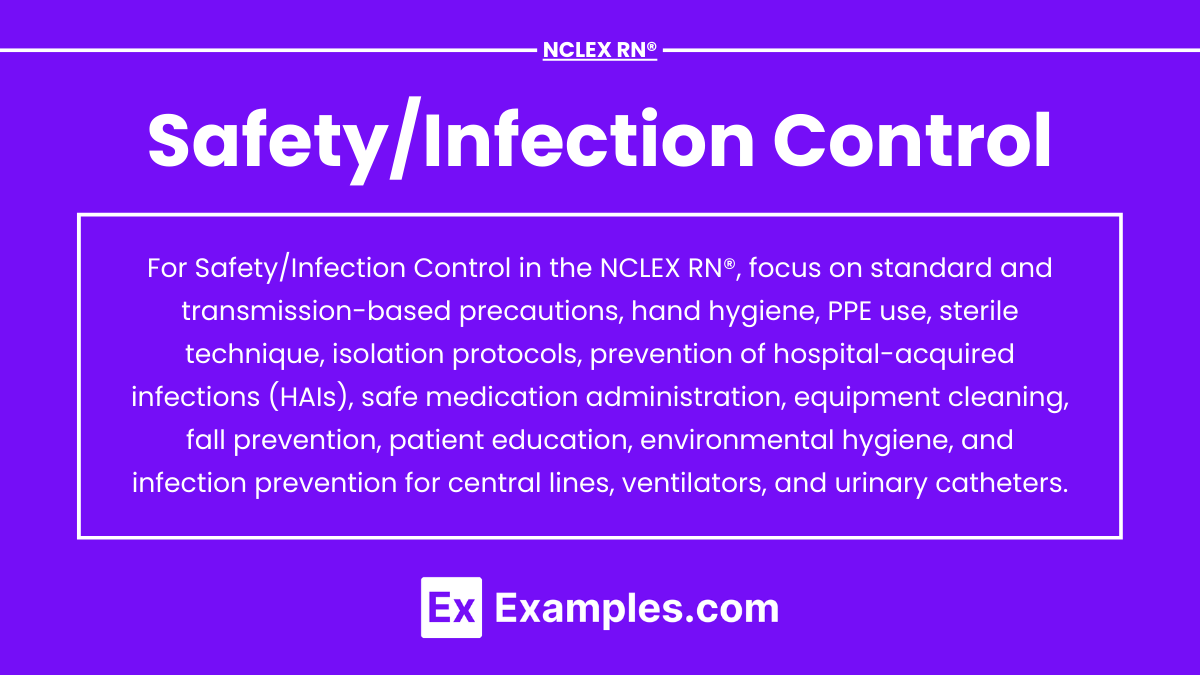Safety and Infection Control are critical components of nursing practice, ensuring the protection of patients, healthcare workers, and the public from harm and healthcare-associated infections (HAIs). For the NCLEX RN®, this topic emphasizes adherence to standard precautions, proper use of personal protective equipment (PPE), and sterile techniques. Nurses must apply isolation protocols, environmental hygiene, and evidence-based interventions to prevent errors and reduce risks. Mastering these principles ensures optimal patient outcomes and prepares nurses to address complex infection control scenarios in various healthcare settings.
Learning Objectives
In studying "Critical Care: Safety/Infection Control" for the NCLEX RN®, you should learn to understand the principles of maintaining a sterile environment and preventing hospital-acquired infections (HAIs). Analyze safety measures like proper hand hygiene, personal protective equipment (PPE), and aseptic techniques in critical care settings. Evaluate protocols such as central line-associated bloodstream infection (CLABSI) prevention, ventilator-associated pneumonia (VAP) management, and catheter-associated urinary tract infection (CAUTI) reduction. Additionally, explore how isolation precautions, environmental hygiene, and patient education contribute to infection control. Apply this knowledge to prioritize patient safety and interpret nursing scenarios in NCLEX-style practice questions.
Key Concepts in Safety/Infection Control

Safety and infection control in critical care settings are pivotal for protecting both patients and healthcare providers. Critical care units often house patients with weakened immune systems, making them susceptible to infections. This necessitates strict adherence to established guidelines and the implementation of advanced preventive strategies.
Hand Hygiene: Hand hygiene is the first and most crucial step in infection prevention. Alcohol-based hand rubs are effective against most pathogens and should be used when hands are not visibly soiled. Soap and water are recommended when hands are visibly dirty or when dealing with patients with C. difficile infections.
Personal Protective Equipment (PPE): Proper use of PPE, including gloves, masks, gowns, and eye protection, helps prevent exposure to infectious agents. Donning and doffing procedures must follow institutional protocols to avoid self-contamination.
Environmental Cleaning: Regular and thorough cleaning of patient rooms, equipment, and high-touch surfaces is critical in minimizing infection risks.
Isolation Precautions: Patients with infectious diseases may require specific isolation measures:
Contact precautions for MRSA or VRE.
Droplet precautions for influenza.
Airborne precautions for tuberculosis or measles.
Aseptic Techniques: Maintaining sterility during invasive procedures, such as inserting central lines or urinary catheters, prevents contamination and infection.
Key Safety Practices in Critical Care

Central Line-Associated Bloodstream Infection (CLABSI) Prevention:
Use chlorhexidine for skin antisepsis.
Adhere strictly to sterile techniques during insertion and maintenance.
Regularly assess the need for the central line and remove it as soon as possible.
Ventilator-Associated Pneumonia (VAP) Prevention:
Elevate the head of the bed to 30-45 degrees.
Perform oral care with chlorhexidine regularly.
Minimize sedation and assess daily for extubation readiness.
Catheter-Associated Urinary Tract Infection (CAUTI) Prevention:
Use urinary catheters only when absolutely necessary.
Maintain a closed drainage system and position the bag below bladder level.
Perform regular perineal care with soap and water.
Medication Safety:
Verify patient identity using at least two identifiers.
Double-check all high-alert medications, such as insulin or anticoagulants.
Clearly label all medication vials and syringes.
Pressure Injury Prevention:
Reposition patients every 2 hours to relieve pressure points.
Use pressure-relieving devices like special mattresses or cushions.
Assess skin integrity daily and apply moisture barriers to protect against breakdown.
Preventing Hospital-Acquired Infections (HAIs):
Implement bundle care protocols, such as hand hygiene, PPE usage, and isolation precautions.
Avoid unnecessary invasive devices like Foley catheters or central lines.
Educate staff and patients on infection control practices to maintain a safe care environment.
Common Scenarios in Infection Control

Handling Multidrug-Resistant Organisms (MDROs): Apply strict contact precautions, limit shared equipment, and educate staff on antimicrobial stewardship.
Outbreak Management in Critical Care Units: Cohort infected patients, enhance cleaning protocols, and notify infection control teams immediately.
Sterile Procedures in Emergency Situations: Ensure rapid but sterile technique during line insertions or intubations to minimize infection risk.
Managing Visitors During Isolation Precautions: Educate visitors on appropriate PPE usage and reinforce the importance of hand hygiene.
Prevention of Surgical Site Infections (SSIs): Maintain sterile technique during surgical procedures, ensure preoperative skin preparation with antiseptics, and administer prophylactic antibiotics as indicated.
Handling Immunocompromised Patients: Implement neutropenic precautions, ensure a low-microbial diet, and limit exposure to infected individuals to protect patients with weakened immune systems from infections.
Examples
Example 1: Hand Hygiene and Aseptic Techniques During Invasive Procedures
Hand hygiene is the cornerstone of infection control, especially in critical care. For example, when inserting a central venous catheter, the nurse must perform thorough handwashing, wear sterile gloves, and use an aseptic technique. This minimizes the risk of introducing pathogens into the bloodstream, preventing central line-associated bloodstream infections (CLABSIs). Proper use of chlorhexidine for skin disinfection and maintaining a sterile field further ensures patient safety.
Example 2: Preventing Ventilator-Associated Pneumonia (VAP)
In patients on mechanical ventilation, safety protocols like elevating the head of the bed to 30-45 degrees and providing oral care with chlorhexidine every 4 hours are essential. These measures reduce the risk of aspiration and bacterial colonization in the respiratory tract. Daily sedation vacations and assessments for extubation readiness are also critical in minimizing the duration of ventilation, thereby reducing the risk of VAP.
Example 3: Implementation of Isolation Precautions
For patients with infectious conditions like MRSA or tuberculosis, strict adherence to isolation precautions is necessary. For contact precautions (e.g., MRSA), the nurse must wear gloves and gowns, and patient-dedicated equipment should be used. For airborne precautions (e.g., tuberculosis), an N95 respirator and a negative-pressure room are required to prevent the spread of airborne pathogens, ensuring the safety of both patients and healthcare providers.
Example 4: Safe Management of Catheters and Drains
Urinary catheters and surgical drains are potential sources of infection if not managed properly. For instance, to prevent catheter-associated urinary tract infections (CAUTIs), the nurse must maintain a closed drainage system, avoid unnecessary catheterization, and perform regular perineal care with soap and water. Routine assessment of the necessity for catheters and prompt removal when no longer needed also contribute to infection control.
Example 5: Environmental Cleaning and Equipment Disinfection
Maintaining a clean environment in the critical care unit is vital. For example, disinfecting high-touch surfaces such as bed rails, IV pumps, and monitors with hospital-approved cleaning agents reduces the risk of pathogen transmission. Shared equipment like blood pressure cuffs and thermometers should be cleaned thoroughly between uses. Proper waste disposal and adherence to hospital cleaning protocols further ensure a safe environment for patients and staff.
Practice Questions
Question 1
A patient in the critical care unit has a central line in place. Which of the following actions by the nurse demonstrates proper infection control? (Select all that apply.)
A. Performing hand hygiene before and after accessing the line.
B. Using clean gloves to change the central line dressing.
C. Cleaning the catheter hub with chlorhexidine for at least 15 seconds before use.
D. Changing the central line dressing only when it becomes visibly soiled.
Answer:
A. Performing hand hygiene before and after accessing the line.
C. Cleaning the catheter hub with chlorhexidine for at least 15 seconds before use.
Explanation: Hand hygiene is a critical step to prevent the spread of pathogens and is required before and after accessing a central line. Scrubbing the hub for 15 seconds with an appropriate antiseptic, such as chlorhexidine, minimizes infection risks.
b. Incorrect: While gloves are necessary, sterile gloves are required for central line dressing changes to maintain a sterile field.
d. Incorrect: Central line dressings should be changed regularly per protocol (e.g., every 7 days if transparent) or sooner if soiled or loose.
Question 2
A nurse is caring for a ventilated patient in a critical care unit. Which of the following interventions best reduces the risk of ventilator-associated pneumonia (VAP)?
A. Administering antibiotics prophylactically.
B. Performing oral care with chlorhexidine every 12 hours.
C. Suctioning the airway every 1-2 hours to prevent secretions.
D. Keeping the patient’s head of the bed flat to ensure comfort.
Answer: B. Performing oral care with chlorhexidine every 12 hours.
Explanation: Oral care with chlorhexidine reduces the colonization of bacteria in the oral cavity, which is a common source of VAP.
A. Incorrect: Prophylactic antibiotics are not routinely used as they can lead to antibiotic resistance.
B. Incorrect: Suctioning should only be performed as needed to prevent trauma to the airway and excessive secretion removal.
D. Incorrect: The head of the bed should be elevated 30-45 degrees to reduce the risk of aspiration, a significant cause of VAP.
Question 3
A nurse is preparing to care for a patient with Clostridioides difficile (C. difficile) infection in the critical care unit. Which of the following actions is most appropriate?
A. Performing hand hygiene with alcohol-based sanitizer after patient care.
B. Wearing a mask when entering the patient’s room.
C. Using a gown and gloves for all patient contact.
D. Cleaning the room with standard disinfectants used for other patients.
Answer: C. Using a gown and gloves for all patient contact.
Explanation: Gowns and gloves are necessary to prevent the spread of C. difficile spores, which can survive on surfaces for prolonged periods.
A. Incorrect: Hand hygiene after caring for C. difficile patients must involve soap and water as alcohol-based sanitizers are not effective against C. difficile spores.
B. Incorrect: Masks are not required unless the patient has another condition requiring droplet or airborne precautions.
D. Incorrect: Rooms must be cleaned with a sporicidal disinfectant, not standard disinfectants, to eliminate C. difficile spores.


